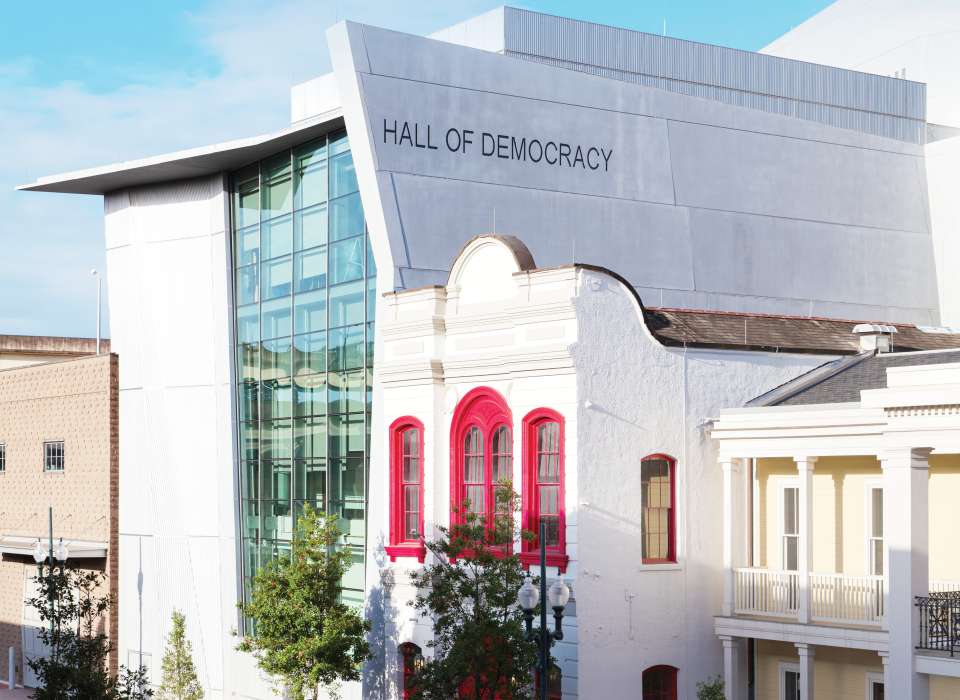NEW ORLEANS (October 17, 2019) – The National WWII Museum today celebrated two significant milestones, each marking a major step toward completing its physical campus: the grand opening of Hall of Democracy and the groundbreaking of Liberation Pavilion. Hall of Democracy—a three-story, state-of-the-art research and education complex—is the newest addition to the Museum’s New Orleans campus in the Arts & Warehouse District. The new center will serve as a preeminent educational gateway to WWII content expertise, iconic materials and unique programming for people across the globe. It will also house the Museum’s research and education departments, a sprawling library, a special exhibition hall, a fully equipped classroom and more.
“The Hall of Democracy will help ensure future growth of the Museum and transformative opportunities to broaden our educational mission through new programming, scholarly research, special exhibits, distance learning, digital initiatives and preservation efforts,” said Stephen Watson, Museum President and CEO. “This stunning addition to our campus will enable us to produce and share the finest historical material and cutting-edge research on World War II, providing Museum visitors and the public better access to even more educational resources.”
Distinct Features
Hall of Democracy will:
- Provide a new home for the Institute for the Study of War and Democracy, the Museum’s research team responsible for assuring the historical integrity of exhibits, programs and publications.
- House the WWII Media and Education Center, which is the epicenter for the production of the Museum’s online and digital content, including distance-learning programs, podcasts, documentaries and the digitization of WWII personal accounts.
- Feature a 2,141-square-foot research library with thousands of works on WWII history for all levels of students and scholars, including a curated collection of published and unpublished personal accounts on the American experience in World War II. The Madlyn and Paul Hilliard Research Library will be open to the public by appointment.
- Additionally contain an education classroom, special exhibition hall, distance-learning studio, 1,706-square-foot lecture and symposium auditorium and a 2,705-square-foot Museum store.
Senator John Alario, Jr. Special Exhibition Hall
The large-scale, 3,764 square-foot special exhibit space within the Hall of Democracy will allow the Museum to present major exhibitions on WWII-related subjects not covered in the institution’s permanent exhibits, as well as more in-depth coverage of subjects that are in the permanent exhibits. The 16-foot-tall space will often present new discoveries and significant themed displays—both allowing the Museum to host more special traveling exhibits and offering the potential to curate and produce more substantial exhibits in-house. The expansive exhibit hall will also provide additional space for Museum programming, educational activities, private receptions and special events. The gallery will help the Museum link iconic artifacts, images and documents to oral histories, archival film segments, maps and geographic details from historic battlefields and other WWII sites.
The special exhibition hall debuts with the opening of “Operation Finale: The Capture & Trial of Adolf Eichmann,” which follows the trial of Nazi war criminal Adolf Eichmann. Presented by Perry and Marty Granoff and on loan from the Maltz Museum of Jewish Heritage in Cleveland, Ohio, the exhibit will be on display through January 5, 2020.
Approaching Campus Completion
The Museum’s grand opening and groundbreaking milestone achievements represent more than just the next steps toward completing the New Orleans campus. They demonstrate the Museum’s commitment to carrying the legacies of World War II into present day, exploring the joys and costs of victory, the horrors of the Holocaust and the war’s continuing effects on our nation.
Liberation Pavilion will mark the final major physical addition to the Museum with three floors exploring the end of the war, the Holocaust, the immediate postwar years and the war’s continuing impact on our own lives. When complete in 2021, the Pavilion will help fulfill the institution’s mission to tell the full story of the American experience in the war that changed the world—why it was fought, how it was won, and what it means today.
As the Museum’s capstone exhibit hall, the Liberation Pavilion will take visitors on an inspiring journey that explores the enormous impact of the war and the ongoing struggle for freedom and democracy. The three-level Pavilion will feature iconic imagery and evocative artifacts, as well as an Interfaith Chapel, an advanced cinematic experience and various multimedia presentations.
The Museum is positioned for the future as it opens doors to Hall of Democracy, debuts “Operation Finale” and begins construction on Liberation Pavilion. As the Museum expands its galleries to share lasting legacies of the war with future generations, it also breaks ground—today—on its future as the nation’s most accessible and trusted source for WWII history.
About The National WWII Museum
The National WWII Museum tells the story of the American experience in the war that changed the world—why it was fought, how it was won, and what it means today—so that future generations will know the price of freedom and be inspired by what they learn. Dedicated in 2000 as The National D-Day Museum and now designated by Congress as America’s National WWII Museum, it celebrates the American spirit, the teamwork, optimism, courage and sacrifices of the men and women who fought on the battlefront and served on the Home Front. The 2018 TripAdvisor Travelers’ Choice Awards ranks the Museum No. 3 in the nation and No. 8 in the world. For more information, call 877-813-3329 or 504-528-1944 or visit nationalww2museum.org.
